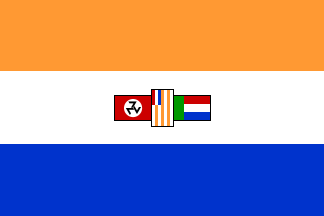
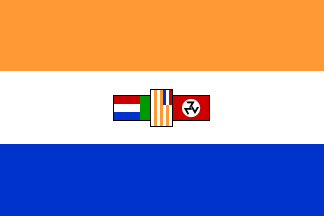 images by Tomislav Todorovic, 06 Sept 2013
images by Tomislav Todorovic, 06 Sept 2013
Last modified: 2023-01-21 by bruce berry
Keywords: south africa | boere weerstandsbeweging | bwb | awb | afrikaner weerstandsbeweging | sevens: 3 | swastika: three legged | neonazi | nazi | boer | african student federation |
Links: FOTW homepage |
search |
disclaimer and copyright |
write us |
mirrors
![[A.W.B. flag]](../images/z/za}awb.gif) image by António Martins, 27 May 1998
image by António Martins, 27 May 1998
The three black 7s (arranged in a fashion similar to the Three
Legs of Man but rotated so that the top seven is upright) is the emblem
of the
Afrikaner Weerstandsbeweging (AWB) (Afrikaner Resistance Movement in
English) which is a right-wing, neo-Nazi organisation) which appears
on its flag (on a white disc at the centre of a red field).
Theo Stylianides, Nov 1996
The flag with three 7's was the original flag of the movement; although it was replaced with the flag charged with the stars and letters AW (shown below) in 1979, it was reintroduced in same year and used ever since. The flag was designed by Jan Groenewald, one of the founders of the movement, and slightly modified by Dries Albert, who was in charge of the movement's propaganda. According to Groenewald himself, the inspiration for the design did come from the Nazi flag. However, the three digits were always described as a Christian symbol, the number 777 having been described as the biblical symbol of perfection and of God himself, as opposed to the number 666 which symbolizes the Antichrist. The symbolic meaning of colours has varied over time.
In 1979, red was officially described as “the colour of the blood which the
Christian Afrikaner had to sacrifice as a guarantee for his self preservation”,
white symbolized “the White race and the purity of our ideal” and black was
“symbol of division and racial authenticity”. In 1988, the official
descriptions were changed: red symbolized “blood of Christ shed on the cross for
our sins" and also "the blood of the Christians shed as a result of persecution
for our faith and the blood of the Boer people shed in their quest for freedom",
white now stood only for “the purity of our ideal”, and black was "the heraldic
symbol for bravery”. This description has remained in use ever since (Sources:
Boerevolkstaat
website; Boerevolkstaat
website and AWB
website).
Tomislav Todorovic, 06 Sept 2013
Notice the white disk is closer to the hoist (like the national
flag of Nazi Germany and unlike most modern
neonazi flags, which have centered discs). I would have expected this
flag to be orange, not red.
António Martins, 18 Apr 1998
[This flag and its symbol are] now also being used by European Nazis
as they have volunteered to fight in a race war in South Africa.
António Martins, 27 May 1998, quoting
Nazism
Exposed | Flags and Symbols (Pål’s site)
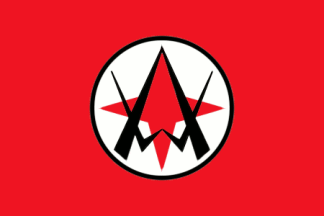 image by Tomislav Todorovic, 06 Sept 2013
image by Tomislav Todorovic, 06 Sept 2013This flag was introduced in
1979, but was withdrawn from official use after a short time and replaced with
the already well-established flag with three 7's described above. The
original flag of the AWB had a red field and star with the letters A and W
in black on a white disc with a black fimbriation. The star was said to have
represented the Star of Bethlehem, and the Christianity in general
(Source: Boerevolkstaat
website).
Tomislav Todorovic, 06 Sept 2013
The AWB had an earlier flag which was similar except that the emblem was
a 4-pointed star with a stylised AW running through it (probably in black).
Theo Stylianides, Nov 1996
Illustrations of the two AWB flags can be found in my article "Flags
of Political Organisations in South Africa" SAVA
Newsletter 2/91, Nov. 1991, p. 7.
Theo Stylianides, Nov 1996
![[AWB’s alternative flag (in Transvaal)]](../images/z/za}awbtv.gif) image
by António Martins, 27 Oct 1999
image
by António Martins, 27 Oct 1999
The Transvaal
vierkleur with
3 black sevens on the white stripe seems to be a once-off flag used on
some or other occasion by followers of the AWB.
Theo Stylianides, Nov 1996
The "777" might be like this or in one of the AWB's usual arrangements:
swastika
or
1+2.
António Martins, 29 Apr 1999
The three "7" are
arranged horizontally in your image while in the image that I have the 7s are arranged in form
of "Trinacria" (i.e. emblem of Isle of Man or Sicily).
I found the following note:
"In 1970, Eugene Terre'Blanche with 6 other kindred souls founded the
Afrikaner Resistance Movement (AWB). From this committee of seven, the
AWB emblem, "Three Sevens", was created in contrast with the number 666
of the satanic forces".
Jaume Ollé, 14 Mar 1999
This symbol is clearly a variation of the Nazi swastika, just one leg
less -- regardless of any other "symbolism" provided for it.
António Martins, 16 Apr 1999

 images by Tomislav Todorovic, 06 Sept 2013
images by Tomislav Todorovic, 06 Sept 2013
![[BWB’s first flag]](../images/z/za}bwb1.gif) image
by António Martins, 04 Oct 1998
image
by António Martins, 04 Oct 1998
This was the flag of Boere Weersdandsbeweging (BWB) (Boer Resistance
Movement in English) which was black with white cross fimbrated red; in the center of the
cross is a white circle fimbrated red with three black "7"s. The BWB was initially
led by Eddie von Maltitz and subsequently by Andrew Ford.
Theo Stylianides, Nov 1996
The flag described above (black field with a white cross fimbriated
red (George, not Scandinavian); three black upright sevens, one above and
two below, on a white disc fimbriated red at the centre) was the original
flag of the BWB. A colour photograph of a crowd waving this flag appeared
in the Sunday Times, Johannesburg during 1990 (unfortunately I don’t have
the exact date).
Theo Stylianides, Nov 1996
![[BWB’s second flag]](../images/z/za}bwb2.gif) image
by António Martins, 04 Oct 1998
image
by António Martins, 04 Oct 1998
When Andrew Ford took over the leadership the flag was replaced by a
similar one instead of having the three 7s, bears the letters BWB in white arranged in a triangular fashion (pointing downwards) on a similarly directed
black triangle.
Theo Stylianides, Nov 1996
Illustrations of the two BWB flags can be found in my article "Flags
of Political Organisations in South Africa" SAVA
Newsletter 2/91, Nov. 1991, p. 7.
Theo Stylianides, Nov 1996
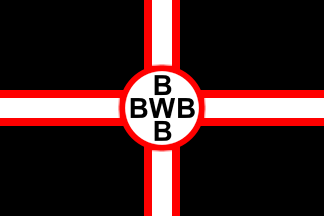 image by Tomislav Todorovic, 06 Sept 2013
image by Tomislav Todorovic, 06 Sept 2013
The current BWB flag has a cross composed of five black
letters, four
B's and one W, arranged on the white disc so as to give the
abbreviation BWB both horizontally and vertically. On the movement's
website
the white cross is described as the symbol of faith and purity, its
red borders as the symbol of both the blood Christ shed on the cross
and the blood Boer people shed in struggle for freedom, and the black
field as the symbol of courage and determination of Boer people.
Tomislav Todorovic, 06 Sept 2013
![[African Student Federation flag]](../images/z/za}asf.gif) image
by António Martins, 18 Apr 1998
image
by António Martins, 18 Apr 1998
The odal rune is used the by
the Afrikaner Student Federation.
António Martins, 18 Apr 1998
Details about the odal rune can be found at
http://www.symbols.com/encyclopedia/39/3922.html
Santiago Dotor, 04 Feb 2005
An odal rune is a "runic letter, (usu. traslit. "ö"), cognate to Greek
omega a.k.a. _ethel_ and _othalan_. .
The rune for odal, i.e. real estate, non-movable property. The odal rune
was the last letter of the runic alphabet, and (here runic letter "ᚠ",
usu. traslit. "f")
for fä (cattle), i.e. movable or personal property, was is the first.
This seems too focused in Viking book keeping; runes were letters, as such with
a lot of usages apart from plain writing down of sound utterances.
This rune, turned upside down, is the symbol of the Scottish Independence Party
and was used at the elections in Great Britain in 1992.
I wonder weather this is more than a coincidence. The saltire-like part of this
letter, BTW, is subjected to such a variation that it appears much less evident
in some instances.
It is also a Swedish twentieth-century graffiti sign conveying a nationalistic
message.
Not only Swedish, and not even primarily so: the Nazi usage of runes as symbols
is known - our site covers it well at naz_symb.html#odal. From there to
neo-Nazi symbolism it's a quick jump. (The referred Swedish usage was reported
to the list and appears in se}naz.html).
António Martins-Tuválkin, 05 Feb 2005
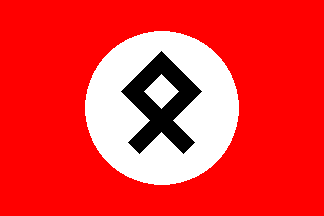 image
by Clive Nel, 12 June 2006
image
by Clive Nel, 12 June 2006
The flag shown for the Afrikaans Student
Federation differs from that shown in the
Illustrated Encyclopedia World Flags Identifier, by Alfred Znamierowski
(Lorenz Books 2000, 2001). The Afrikaans Student Federation flag is shown in colour
on page 118. The flag differs from that shown here in that the
Odal-Rune lacks the 'feet-like' bits sticking out at the bottom.
The type of Odal-Rune shown in the book was also widely used by
right-wing nationalist youth groups like the Wiking Jugend in Germany and
other counties but
was banned in Germany in 1994. The flag used by the Wiking Jugend
was black with a red Odal-Rune in its centre.
Arthur Read, 16 May 2006
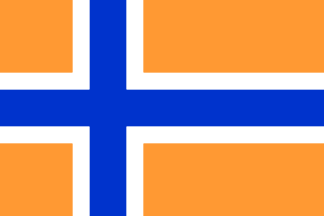 image by Tomislav Todorovic,
30 Sept 2013
image by Tomislav Todorovic,
30 Sept 2013
Bravoland is a "cyber-state" created in 2007 with the intention to provide a
"cyber-homeland" for the Afrikaner/Boer people. Its flag, called the
Triomfvlag (Triumph Flag in Afrikaans) is orange, with a blue
Scandinavian-type cross bordered white. Unlike the "state" it represents, the
flag is not virtual at all, and copies are used in real life which have been
photographed many times so far as can be seen
here,
here and
here.
Tomislav Todorovic, 30 Sept
2013
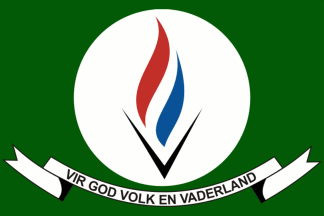 image sent by Tomislav Todorovic, 01 Oct 2013
image sent by Tomislav Todorovic, 01 Oct 2013
The Boere Youth (Boerejeug in Afrikaans) is the youth wing of
Afrikaner Resistance Movement. Its flag is green with a
large white disc, upon which is a black torch with tricolor red-white-blue
flame; beneath the disc is a white ribbon with black inscription VIR GOD, VOLK EN VADERLAND ("For God, People and Fatherland"). The flame symbolises life, hope,
freedom and faith, while its colours stand for patriotism and the shape of the
torch, resembling two hands around the flame, symbolizes God's protection of the
people. The white disc stands for honesty, humility and purity and green field
symbolizes youth, growth and new life (Source: Afrikaner Resistance Movement
website).
Tomislav Todorovic, 01 Oct 2013